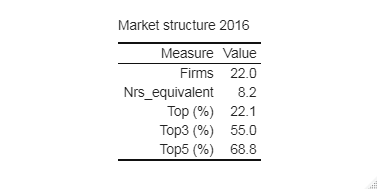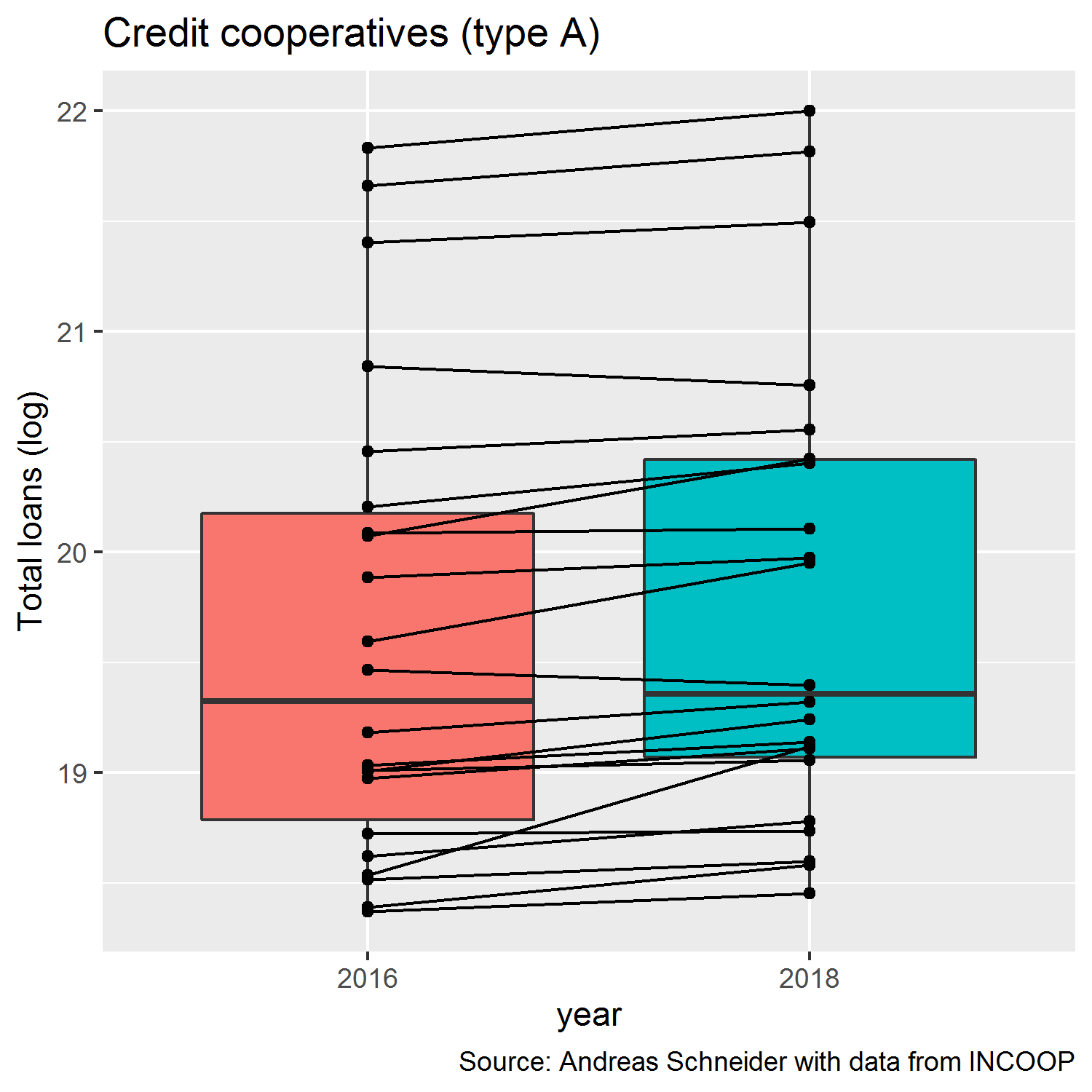
Introduction to concstats
Andreas Schneider
Last updated 2025-12-16
Source:vignettes/concstats-intro.Rmd
concstats-intro.RmdThe goal of the concstats package is to offer a set of
alternative and/or additional measures to better determine a given
market structure and therefore reduce uncertainty with respect to a
given market situation. Various functions or groups of functions are
available to achieve the desired goal.
Installation
You can install concstats directly from CRAN or the
latest development version from github (requires remotes or
devtools) remotes::install_github(“ropensci/concstats”)
Then, load the package.
Data
The following examples use mainly fictitious data to present the
functions. However, if you want to test the functionality in more
detail, the package comes with a small data set of real Paraguayan
credit cooperatives (creditcoops). There are 22 paired observations for
real Paraguayan credit cooperatives (with assets > 11 Mio. USD) for
2016 and 2018 with their respective total loans granted. For a better
visualization there is an additional column with the transformed total
loans. For further information on the data please see the
creditcoops help
file. For a practical implementation you might be interested to read the
following article.
data("creditcoops")
head(creditcoops)
#> # A tibble: 6 × 5
#> coop_id year total_loans paired total_loans_log
#> <dbl> <fct> <dbl> <int> <dbl>
#> 1 1 2016 173892358 1 19.0
#> 2 1 2018 199048199 1 19.1
#> 3 2 2016 323892456 2 19.6
#> 4 2 2018 461609439 2 20.0
#> 5 3 2016 179981404 3 19.0
#> 6 3 2018 227232008 3 19.2Group wrapper overview
At the moment, there are the following groups of functions
available:
- concstats_mstruct() is a wrapper for market structure
measures
- concstats_inequ() is a wrapper for inequality and
diversity measures
- concstats_comp() is a wrapper with different
concentration measures
- concstats_concstats() is a function which calculates a
set of pre-selected measures in a one step procedure to get a quick
overview of a given market structure
The functions will be presented in more details in the following short step-by-step guide.
Examples
We will use a vector which represents market participants with their respective market shares (in decimal form):
concstats_mstruct
The wrapper includes the following arguments to calculate individual
functions: firm, nrs_eq, top,
top3, top5, and all. You can also
pass the additional argument digits to all,
which controls for the number of digits to be printed.
All individual functions can be accessed directly with the prefix
“concstats_” (e.g. “concstats_firm” or “concstats_all_mstruct”). The
concstats_top_df functions also take a data frame as input, since the
ranking of firms and their identification might be of interest.
x <- c(0.35, 0.4, 0.05, 0.1, 0.06, 0.04, 0, 0)
test_firm <- concstats_firm(x) # number of firms
test_firm
#> [1] 6You should have noticed that the market shares are in decimal form.
However, you can use integers or floating point numeric types to express
market shares. Allconcstats functions will take care of
this and convert theses vectors into decimal form. There are eight
market participants, however, two have no market shares, by default
concstats treats 0 as NA. The result is a cumulative top 5
market share of 96 %.
You can also access each function through their respective argument in
the group wrapper:
x <- c(0.35, 0.4, 0.05, 0.1, 0.06, 0.04, 0, 0)
test_share_top5 <- concstats_mstruct(x, type = "top5") # top3 market shares in %
test_share_top5
#> [1] 96Or, just calculate all measures of the group wrapper, and store it in a named object.
x <- c(0.35, 0.4, 0.05, 0.1, 0.06, 0.04, 0, 0)
concstats_all_mstruct(x, na.rm = TRUE, digits = 3)
#> Measure Value
#> 1 Firms 6.00
#> 2 Nrs_equivalent 3.33
#> 3 Top (%) 40.00
#> 4 Top3 (%) 85.00
#> 5 Top5 (%) 96.00The result is a data frame of market structure measures.
concstats_inequ
The inequality and diversity group has the following arguments:
entropy, gini, simpson,
palma, grs, and all.
They can also be accessed as individual functions.
x <- c(0.35, 0.4, 0.05, 0.1, 0.06, 0.04)
test_share_entropy <- concstats_entropy(x)
test_share_entropy
#> [1] 0.787806
# and as a non-normalized value
test_share_entropy2 <- concstats_entropy(x, normalized = FALSE)
test_share_entropy2
#> [1] 2.036449concstats_comp
The group wrapper for competition measures includes the following
arguments to calculate hhi, hhi_d,
hhi_min, dom, sten, and
all.
x <- c(0.35, 0.4, 0.05, 0.1, 0.06, 0.04, 0, 0)
test_share_hhi <- concstats_hhi(x)
test_share_hhi
#> [1] 0.3002
# a normalized value
test_share_hhi2 <- concstats_hhi(x, normalized = TRUE, digits = 3)
test_share_hhi2
#> [1] 0.16
# the min average of the hhi
test_share_hhi3 <- concstats_comp(x, type = "hhi_min")
test_share_hhi3
#> [1] 0.1666667concstats_concstats
A single function which calculates a set of eight pre-selected measures in a one step procedure for a first overview of a given market structure. The resulting data frame contains eight measures, which are: number of firms with market share, numbers equivalent, the cumulative share of the top (top 3 and top 5) firm(s) in percentage, the hhi index, the entropy index, and the palma ratio.
x<- c(0.2, 0.3, 0.5)
test_share_conc <- concstats_concstats(x, digit = 2)
test_share_conc
#> Measure Value
#> 1 Firms 3.00
#> 2 Nrs_equivalent 2.63
#> 3 Top (%) 50.00
#> 4 Top3 (%) 100.00
#> 5 Top5 (%) 100.00
#> 6 HHI 0.38
#> 7 Entropy 0.94
#> 8 Palma ratio 2.50Visualization
The scope of the package is to calculate market structure and
concentration measures to get a quick and more informed overview of a
given market situation. However, it is good practice to visualize your
data in an exploratory step or in reporting your results. The package
concstats works fine with other Exploratory Data Analysis
(EDA) packages or data visualization packages e.g. overviewR,
dataexplorer,
kableExtra
or ggplot2
to name a few.
Some examples on how you can accomplish this. Let us assume one would
like to use the group measure for e.g. market structure, and keep the
resulting data frame. We can refine the table using
kableExtra which works nice with knitr.
This time, we will use our creditcoops data set again,
which comes with the package.
data("creditcoops")
head(creditcoops)
#> # A tibble: 6 × 5
#> coop_id year total_loans paired total_loans_log
#> <dbl> <fct> <dbl> <int> <dbl>
#> 1 1 2016 173892358 1 19.0
#> 2 1 2018 199048199 1 19.1
#> 3 2 2016 323892456 2 19.6
#> 4 2 2018 461609439 2 20.0
#> 5 3 2016 179981404 3 19.0
#> 6 3 2018 227232008 3 19.2You will need the following two packages. Make sure you have these packages installed.
Now, we will filter out data for the year 2016.
#data("creditcoops")
coops_2016 <- creditcoops |> dplyr::filter(year == 2016)
head(coops_2016)
coops_2016 <- coops_2016[["total_loans"]] # atomic vector of total loans
coops_2016 <- coops_2016 / sum(coops_2016) # market shares in decimal form
# We then use the new object `coops_2016` to calculate the market structure
# measures as a group in a one-step-procedure and capture the results in a
# printed table:
coops_2016_mstruct <- concstats_mstruct(coops_2016, type = "all",
digits = 2)
coops_2016_mstruct_tab <- coops_2016_mstruct |>
kableExtra::kbl(caption = "Market structure 2016", digits = 2,
booktabs = TRUE, align = "r") |>
kableExtra::kable_classic(full_width = FALSE, html_font = "Arial")
coops_2016_mstruct_tabThe result is a nice reusable table.

Now, let’s go a step further. We will compare the two samples for
2016 and 2018. For this purpose, we will select from our
creditcoops data set the relevant columns (coop_id, year,
paired, and total_loans_log) and make a new data frame.
Make sure you have the ggplot2 package installed. Load
the package.
library(ggplot2) # Data Visualizations Using the Grammar of Graphics
df_shares_plot <- df_shares |>
ggplot(aes(year, total_loans_log, fill = year)) +
geom_boxplot() +
geom_point() +
geom_line(aes(group = paired)) +
labs(title = "Credit cooperatives (type A)", y = "Total loans (log)",
caption = "Source: Andreas Schneider with data from INCOOP") +
theme(legend.position = "none")
df_shares_plot
Having a look a the output, we see a box plot with paired values of the cooperatives and the evolution of their respective total loans over time for the two sample years 2016 and 2018.